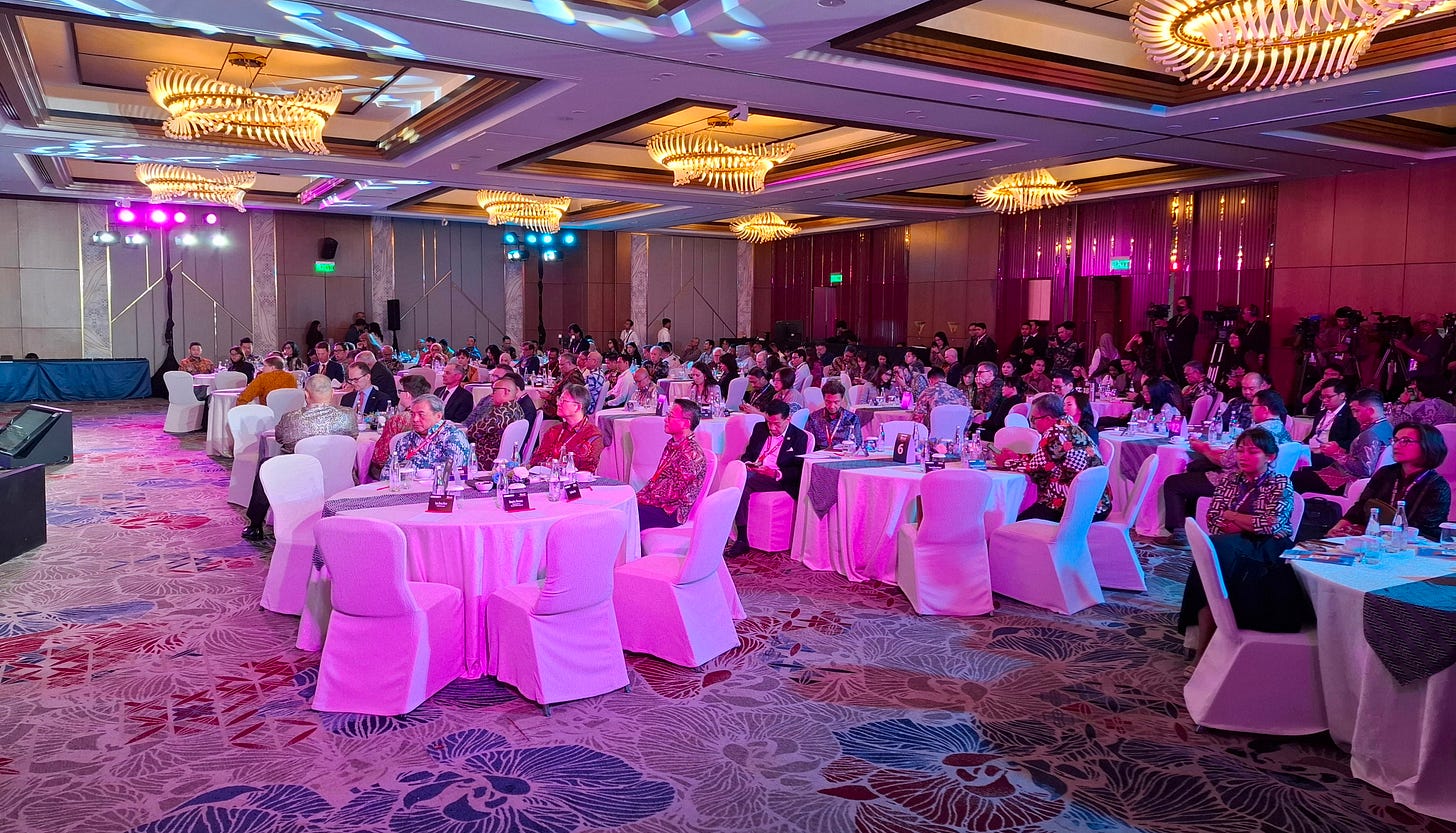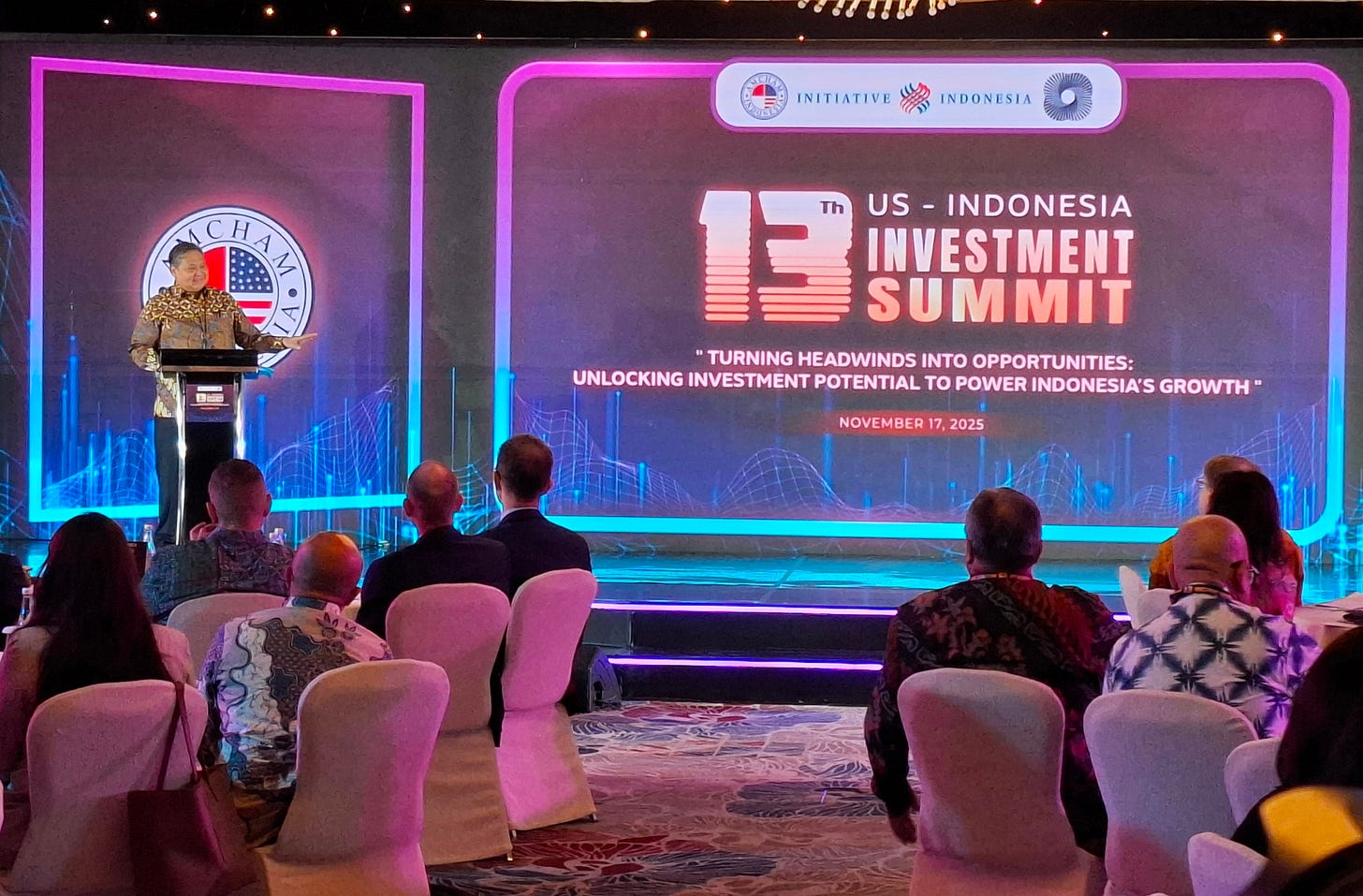U.S. and Indonesia explore policy reforms to accelerate business expansion
U.S. companies want bureaucracy to be simpler, more transparent, and predictable

The Main Takeaway 🎯
The U.S. Chamber of Commerce and American Chamber of Commerce (AmCham) in Indonesia, held the 13th Investment Summit on Monday (11/17) in Jakarta.
Under the theme “Time for Bold Policy Reform,” the one-day event gathered 150 business executives from Indonesia and the Asia-Pacific region to engage with the Indonesian government and explore ways to speed up and grow their business activities in the country.
Why It’s on Our Radar 🔍
🇮🇩🇺🇸 Political transitions
Indonesia’s leadership shifted from Jokowi to Prabowo (Oct 2024), while the U.S. moved from Biden to Trump (Jan 2025) — reshaping diplomacy, trade, and investment policies.
📈 Indonesia’s ambitions
Jakarta wants 8% GDP growth by 2029 and aims to be among the world’s top five economies by 2045.
💸 U.S. tariff impact
Starting April 2025, the U.S. will impose 11–50% reciprocal tariffs on partners, including a negotiated 19% tariff on selected Indonesian exports.
🏛️ Investor sentiment
U.S. companies — many with decades in Indonesia — want clearer rules, stronger legal certainty, and a level playing field with SOEs.
“Without a robust supportive and certain investment ecosystem, Indonesia advantages risk become an only illusion rather than opportunity, our potential will remain as potential only.” (Donna Priadi, Managing Director AmCham Indonesia)
Why It Matters ⚠️
🇮🇩 Prabowo vs. Jokowi
Prabowo adopts a more assertive, personal diplomacy; Jokowi preferred behind-the-scenes engagement.
🇺🇸 Trump vs. Biden
Trump’s approach: transactional, forceful, competition-driven.
Biden’s approach: coalition-focused, diplomacy-first.
💼 Big economic targets
To reach its 8% growth target, Indonesia needs IDR 13,032 trillion in investment and 19 million new jobs.
📊 A challenging investment climate
65% of U.S. companies cite regulatory uncertainty and complex bureaucracy.
57% struggle to find skilled workers.
43% face infrastructure constraints.

Why This Hits Home ❤️
🌏 Indonesia’s potential
With 280 million people, a strategic location, and rich natural resources, Indonesia anchors 40% of ASEAN’s population and 34% of its GDP.
🇺🇸 75 years of U.S.–Indonesia ties
Bilateral goods trade hit USD 38.2B in 2024, with Indonesia posting a USD 17.9B surplus.
💰 U.S. investment footprint
U.S. companies invested USD 67B in Indonesia over the past decade, generating USD 130B in economic output.
🏦 Danantara Fund
Prabowo’s new sovereign wealth fund will manage nearly USD 1 trillion from 1,000 SOEs.
🌍 OECD membership
Indonesia is seeking OECD accession to boost transparency, regulatory reforms, and investor confidence.
The Big Picture 📸
Both Indonesia and the U.S. outlined key priorities:
🇺🇸 U.S. Priorities
• Digital economy, data governance, and e-commerce
• Stronger IP protection
• Open cross-border data flows
• Regulatory consistency for investors
🇮🇩 Indonesia’s Priorities
• Job creation and innovation
• Higher-value investment
• Energy transition and critical minerals
• Skills development and productivity
🏭 Business Needs
• Transparency and predictable regulation
• Mutual recognition of standards
• Reduced bureaucracy
• Level playing field for private firms
“We welcome Indonesia’s public commitment, the Indonesian government’s public commitment to help work with us in achieving more fairness and balance in our trading relationship, and at the same time, strong Indonesian leadership to ease import restrictions and licensing requirements, to enforce intellectual property rights, to allow cross-border data flows that will attract more U.S. investment here, when and if those reforms are put in place, and as they increase Indonesia’s competitiveness when American firms are looking to Southeast Asia for investment“. (Peter Haymond, Charge d’Affairs, U.S. Embassy)
What’s at Stake ⚖️
🇺🇸🇮🇩 Navigating Tariffs
Indonesia seeks:
• 0% tariff on CPO, rubber, tea, coffee
• USD 10B investment in U.S. blue ammonia
• USD 15B U.S. energy imports
• USD 4.5B U.S. agricultural purchases
• 50 new Boeing jets for Garuda
• Adequacy status for cross-border data sharing
🏗️ Business Challenges
• Inconsistent TKDN (local content) implementation
• Ambiguous rules for data transfer under PDP Law
• Strict SPS and labeling requirements
• Complex licensing and fragmented digital systems
“I think it is important for Indonesia that amidst the global uncertainties, Indonesia will still be able to manage 5 percent growth in the third quarter. And actually, Indonesia in the last seven years grew at 5 percent. So in the last seven years, the Indonesian economy grew at 35 percent.” Airlangga Hartarto, Coordinating Minister of Economic Affairs.

Investment Challenge
According to AmCham, U.S. businesses face several challenges when expanding in Indonesia:
Local content uncertainty: Companies must conduct R&D, set up assembly lines, and adjust products to meet the local content requirement. However, in practice, the rule is flexible due to inconsistent regulations and varying interpretations across ministries.
Data transfer & privacy concerns: Indonesia will share some data with U.S. companies for cross-border business, but the implementation rules are still pending. This also raises civil society concerns about potential misuse of personal data.
Agriculture & SPS barriers: Indonesian exporters must meet sanitary, labeling, and pre-shipment inspection standards to reduce compliance issues for importers.
Bureaucratic capacity: Indonesia’s complex licensing and import procedures — worsened by poor system integration and limited public consultation — reduce investor interest.
Recommendation
U.S. businesses call for reforms in:
• Governance — restore independence of oversight bodies
• Regulatory clarity — simplify licensing & quotas
• Local-content policy — shift from rigid rules to incentive-based frameworks
• Standards alignment — adopt global testing norms
• Digital openness — enable offshore data processing with safeguards
• Sustainability — new rules for CCS and circular economy
• Evidence-based policymaking — institutionalize Regulatory Impact Assessments
Regional Lens 🌏
🇸🇬 Singapore: USD 38.2B U.S. FDI (2024)
🇲🇾 Malaysia: USD 2.8B (2024)
🇵🇭 Philippines: USD 890M (2024)
🇻🇳 Vietnam: USD 287M (2024)
🇧🇳 Brunei: USD 2.5M (2024)
🇹🇭 Thailand: Google’s USD 1B data center investment (2024)
Cambodia, Laos, Myanmar, Timor Leste: No available data
The U.S. remains ASEAN’s largest FDI source despite global uncertainty.
Need More Angles?
AmCham 2025 : A Year of Transition
ASEAN ASEAN Investment Report 2025: Foreign Direct Investment and Supply Chain Development
Bangko Sentral Ng Pilipinas FDI Posts US$110 Million Net Inflows in December 2024; Full-Year Level Reaches US$8.9 Billion
Brunei Darussalam’s Ministry of Finance and Economy Foreign Direct Investment Statistics 2024
Department of Statistics Singapore Foreign Direct Investment In Singapore By Source Economy (Flows)
Thailand Board of Investment Thailand BOI Says 2024 Investment Applications Soar 35% to 10-Year High of USD33 Billion as FDI in Data Centers and Cloud Services Take the Lead
Vietnamese Ministry of Planning & Investment FDI attraction situation in Vietnam and Vietnam’s overseas investment in 2024
(NGO/ELS/QOB)





